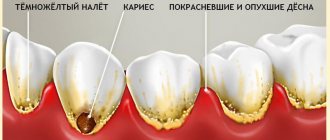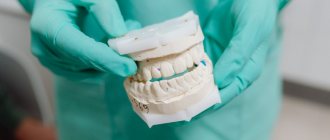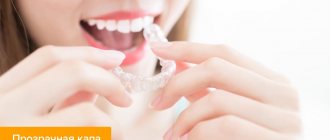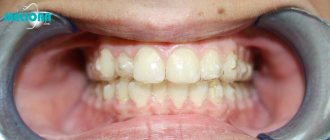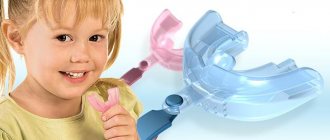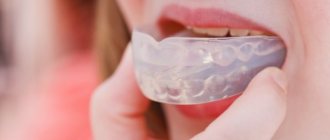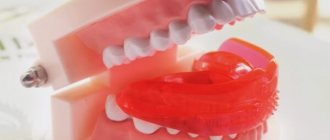Braces price for bite correction
| Consultation with an orthodontist | FOR FREE |
| Alginate impression | 1000 rub. |
| Diagnostic model calculation | 2500 rub. |
| Making a diagnostic model (2 pcs.) | 2500 rub. |
| Observation during the treatment phase | 1000 rub. |
| Treatment of malocclusions (bite alignment) | from 70,000 rub. |
| Fixation of one bracket on NO MIX material | 1800 rub. |
| Fitting and applying the arc | 500 rub. |
| Tying the arch to one bracket | 400 rub. |
| Fixation of elastic traction (1 link) | 500 rub. |
| Setting the spring | 800 rub. |
| Making a wire retainer and fixing it | 5000 rub. |
| Making a retention splint | 5000 rub. |
| Manufacturing of an orthodontic plate with 2 clasps from imported plastic | 11000 rub. |
| Manufacturing of 2-jaw apparatus, regulators, bionators and various modifications of functional apparatus | 16,000 rub. |
| Positioner | 15,000 rub. |
| Cementation of the orthodontic ring | 850 rub. |
| Removing one bracket | 500 rub. |
| Removing one ligature | 300 rub. |
| Clinical correction of the device | 1000 rub. |
| Repair of orthodontic apparatus (in the laboratory) | 2500 rub. |
| Activation of the orthodontic appliance | 1000 rub. |
| Fitting and fixing the palatal clasp | 1500 rub. |
| Correction of teeth with the INVISALIGN system (excluding the technical part) | from 70,000 rub. |
| Photo recording (1 photo) | 250 rub. |
| Surgery to install an orthodontic implant | 11000 rub. |
| Taking a one-step two-layer impression (A-silicone) | 3250 rub. |
Cost of aligners
At the PROPRICUS clinic, the price for teeth straightening without braces in adults is fixed. The price includes diagnostics of the jaw joints, drawing up a treatment plan, taking impressions, making mouth guards and repeated consultations. The patient does not need to worry about additional costs.
The amount depends on the duration of treatment with Invisalign aligners:
- 270,000 rubles
- treatment for up to six months; - 320,000 rubles
– treatment for up to one and a half years; - 370,000 rubles
- treatment for one and a half years.
Make an appointment
Correction of distal bite
A characteristic feature of the distal bite is the protruding front teeth of the upper row. Dentists recommend correcting the bite in dentistry when the upper jaw seems overdeveloped compared to the lower jaw. In this case, a person’s chewing load on the teeth is disrupted, as a result of which the posterior lateral sections become susceptible to an increased risk of developing caries, and soft tissues to the development of periodontal disease. From the outside, it appears that the patient's face has a small chin. Thus, orthodontists achieve an even distribution of proportions to all parts of the face. To select defect correction designs, dentists take into account the patient’s age. In early childhood, bite correction methods are used to restrain the growth of the upper jaw and stimulate the development of the lower jaw. In adults, preference is most often given to braces.
Plates for teeth: removable and non-removable
In dentistry, doctors work with different types of orthodontic products. At the initial appointment, the orthodontist will tell the young patient and his parents what the plates for straightening teeth are called, how they differ and what they are like. The most popular:
- systems – single-jawed, with a retraction arch, with a pusher, with a hand-shaped process;
- devices – Brückle, Frenkel;
- Andresen-Goipl activator.
Products are divided according to the method of fixation:
- removable – hypoallergenic polymer construction includes wire hooks and arcs for fixing the plate;
- non-removable – they look like metal brackets that put pressure on the teeth from the outside, forming the correct bite.
A removable dental plate is placed on children to correct simple bite defects. The optimal age of a child for correction is 5-12 years. Fixed products can compete in effectiveness with braces; they are usually recommended for teenagers to eliminate serious anomalies of the dentition.
Braces are non-removable orthodontic structures in which a plate is placed on each tooth, and an arch with a “memory effect” is responsible for correcting the bite. Metal braces are the most effective, but sapphire and ceramic braces are almost invisible on the teeth. There are also ligature braces with rubber bands and self-ligating ones, which reduce the treatment period by several months.
Correction of mesial bite
People with this defect tend to have a protruding chin. If the flaw is inherent in a man, then the aesthetics may not be disturbed, since the face takes on a strong-willed and decisive expression. When a girl is susceptible to the defect, bite correction is required immediately. The consequences are as varied as with distal closure of teeth. This is the risk of early onset of periodontal diseases, the development of caries, and the complexity of prosthetics.
Mesial correction of occlusion in adults is a lengthy process. The sooner orthodontic treatment is carried out, the sooner the result is achieved. The ideal time for this is considered to be childhood, when the development of the jaw apparatus is not yet complete. In this case, different removable structures are used. In adults, dental braces, possible removal of some row elements, and orthognathic operations are most often used.
Why is it important to correct your bite with braces?
There are several reasons why you should choose professional orthodontic treatment. The first and most obvious benefit is that you get a beautiful smile.
Crooked, incorrectly positioned teeth can be a source of serious complexes. Patients with this problem often purse their lips tightly, avoiding a wide smile. Braces will allow you to enjoy straight, correctly positioned teeth and a radiant, sincere smile.
In addition to the visible aesthetic effects, orthodontic treatment also greatly affects the patient's health. Correction of dental abnormalities helps reduce excessive wear of enamel caused by, among other things, congenital or acquired malocclusion.
It is important to note that properly positioned teeth simplify hygiene and promote oral health - it is much easier to remove food debris, reaching the most secluded corners. Thus, correcting the bite prevents the development of caries and periodontal diseases. It is also necessary to remember that malocclusion is the cause of diseases of the temporomandibular joint and headaches. Correcting dental irregularities with orthodontic appliances can help completely eliminate pain if it was caused by dental misalignment.
Correction of deep bite
Ideally, the top row protrudes slightly forward and covers the bottom row by 1/3. When the teeth cover the underlying elements by more than half, we are talking about a deep form of malocclusion. Correction of dental occlusion is required due to an aesthetic defect in which the face is not elongated enough along the vertical axis, and the lower lip protrudes. The owner of such a defect also faces functional problems, due to which periodontal diseases develop, teeth become loose, gums become inflamed, mechanical damage to soft tissues often occurs with teeth, and enamel quickly wears off.
If teeth are not corrected on time, the functioning of the jaw joint is disrupted, and a crunching sound appears when the jaw moves. Clicking sounds may be heard and symptoms of pain may occur. When dental prosthetics is performed, this pathology is also subject to correction. Dentists use treatment based on a number of structures that increase the level. The device can be a brace system, special plates and other products.
How to brush teeth with braces?
Patients starting orthodontic treatment should be prepared for the fact that their teeth will require more careful care. Food debris can stick to your braces, so brush your teeth after every meal. To do this, you should use two brushes - a standard one and a specialized one, designed for cleaning hard-to-reach places. When choosing a suitable toothbrush and toothpaste, you should consult with an orthodontist at the ILATAN clinic. You can make an appointment for a consultation regarding the selection and installation of a brace system to correct your bite by calling +7 (495) 748-50-50.
Crossbite correction
The pathology manifests itself in the weak development of one side of the jaw. Surgical correction may be required, although in some cases the defect can be treated with removable and permanent repairs. It is observed on one or both sides of the jaw, on any zone of the row - front or side. Leads to severe impairment of chewing functionality. Frequent companions of the defect are early periodontal disease, caries, crunching and pain when opening the jaws. You can apply for correction yourself. The dentist who provides dental treatment or selects the type of prosthetics to restore the integrity of the rows may also recommend undergoing the procedure for correcting the defect.
How did medicinal mouthguards appear?
In the territory of the former USSR, the first attempts to treat bite defects with plastic mouthguards were made back in the 70s of the twentieth century. Impressions were taken of the patient’s teeth, and a mouthguard was made from them, which had to be worn for a certain period of time. Then they made impressions again, a new mouth guard - and so on until the defect was corrected. The effectiveness of the treatment was low, and the process itself dragged on for years.
The revolution in orthodontics was carried out by Align Technology, which developed, patented and launched the first aligners on the market in 1998. In terms of effectiveness and duration of treatment, they do not differ from braces. However, there may still be limitations when correcting overly complex bite defects.
What are the dangers of malocclusion?
People with malocclusion suffer from pathology every day. According to statistics, deficiency is observed in 80% of the world's population. In some situations, the defect is purely an aesthetic imperfection, but sometimes its presence entails functional and psychological problems. A person who has had their bite corrected looks different before and after the procedure. Along with the defect, the contour of the face is evened out, its proportions become clearer and more correct. The smile takes on perfect features.
If a major correction is required, a specialist may resort to surgery. For uncomplicated pathology, removable and non-removable systems are sufficient. An inharmonious bite often becomes the cause of self-doubt and complexes. At the physiological level, there is increased sensitivity of soft tissues and an increased risk of injury.
The situation can be aggravated by the appearance of problems with the gastrointestinal tract, since food often does not receive proper processing in the oral cavity and enters the stomach in “piecemeal” form. Today, bite treatment is used by orthodontists in any age group. With a properly prescribed set of procedures, the deficiency can be eliminated easily and painlessly. Even if a surgical method is used, the use of anesthesia in a difficult situation neutralizes pain impulses.
Alignment methods for adults
Teeth straightening without braces in adult patients is used only in cases of uncomplicated pathologies. For example, the use of aligners - transparent trays made of polymer materials - allows you to correct the unevenness of the incisors and the density of the dentition.
To correct and disguise smile defects in adults, use:
- aligners;
- veneers and lumineers;
- prosthetics;
- restoration with composite materials.
At the same time, a corrective effect without unpleasant consequences is provided only by the use of aligners, the cost of a course of treatment of which in some cases is significantly higher than the price of a braces system. But even high-quality mouthguards will not help straighten teeth without braces for adults with serious pathology.
Teeth straightening with aligners
Aligners
- These are orthodontic aligners made of transparent polymers. Elastic but resilient supports placed over the upper and lower jaws that apply gentle pressure to guide the teeth into the correct position.
Aligners for teeth straightening
Teeth straightening with aligners occurs gradually and includes regular replacement of linings with denser ones. Each mouthguard is made individually based on the patient's orthodontic impressions.
Duration of treatment
depends on the complexity of the pathology and the type of aligners used. On average, it is 8-12 months of continuous - at least 20 hours a day - wearing the pads. If the expected correction time exceeds 1 year, then it is recommended to resort to teeth straightening with braces, as a faster and more effective method.
Types of aligners.
The effectiveness of treatment and its cost depend on the correct choice of an orthodontic mouth guard. Different manufacturers use their own technologies for producing aligners, and not all of them meet modern requirements. Therefore, when choosing devices, follow your doctor’s recommendations and give preference to certified products that have been tested and have real patient reviews.
Let's look at the most popular brands of orthodontic aligners used in Russian clinics:
Aligner Manufacturers
- Invisalign
is a development of Aling Technology (USA), the most experienced aligner manufacturer in the world. The mouthguard is manufactured using high-tech ClinCheck Pro software, which allows you to accurately predict the final result of therapy. With the help of this company's product there is a high probability of correcting severe malocclusions. The cost of a course of treatment, which involves replacing the lining every two weeks, ranges from 168 thousand rubles. - OrthoSnap
is an American company that produces more affordable aligners. Mouthguards are made from our own materials using Dynamic Physical Model technology without the use of computer modeling. Effective against minor defects such as diastema, crooked teeth. They do not allow you to predict the result. The cost of treatment with OrthoSnap aligners starts from 100 thousand rubles. - Star Smile
is a Russian analogue of American designs, produced by a young company. Uses 3D modeling programs, but does not have high manufacturing technologies. The use of aligners from this manufacturer gives good, predictable results in correcting minor defects in the anterior teeth. Due to the reduction in delivery costs, the price of treatment is lower than when using foreign aligners (from 80 to 160 thousand rubles). - Avantis 3D
is another Russian brand. In the production of aligners, we also use computer modeling and 3D technologies. This is one of the most affordable methods of treating jaw pathologies; the cost of treatment starts from 40 thousand rubles. But these mouthguards are not capable of correcting severe disorders.
The feasibility of treating malocclusion with aligners is assessed by an orthodontist. After all, even expensive high-tech mouth guards will not give the expected result in correcting severe pathologies.
Advantages of aligners:
- the ability to remove for eating and dental care;
- invisibility on teeth;
- do not cause allergies;
- do not injure the soft tissues of the oral cavity.
The main positive quality of the onlays is the ability to carry out usual oral hygiene, which significantly reduces the risk of caries.
Transparent aligners are almost invisible on the teeth
Cons of aligners:
- ineffective for severe disorders;
- have high treatment costs;
- cause discomfort when eating in public places;
- long production;
- unreliable fixation.
As we can see, the main disadvantage of the devices is the inability to correct complicated anomalies.
Price.
It directly depends on the chosen brand of aligners. Thus, treatment with Russian-made mouthguards will cost 40 thousand rubles or more, and the cost of using American high-tech developments reaches 280 thousand.
Veneers
Veneers
- These are overlays for teeth made of composite materials or porcelain. Designed to hide aesthetic smile defects.
Veneers are thin plates that are fixed to the outer surface of the teeth. Service life up to 10 years.
Veneers are coverings for teeth
Overlay thickness up to 0.5 mm. To make it look inconspicuous, the enamel is ground down by 0.3–0.7 mm.
It is impossible to straighten teeth with veneers. They are used to mask pronounced defects: chips, cracks, different heights of teeth.
Pros:
- invisible, as they are matched to the color of the patient’s enamel;
- short adaptation period, cannot be felt on the teeth just a few hours after installation;
- quick fixation procedure, instant results.
Veneers are matched to the color of tooth enamel.
Veneers easily cope with their task - masking unpleasant features of teeth, but do not solve problems with bite.
Minuses:
- the method requires grinding down the enamel;
- the need to repeat the procedure every 10 years or less;
- expensive treatment.
Veneers are used to correct minor defects. Plates are not able to hide pronounced abnormalities in the position of the teeth.
Price.
Installing one record costs 20 thousand rubles and more. The cost depends on the materials used and the complexity of the work.
Lumineers
Lumineers
– these are overlays on teeth, similar to veneers, but unlike the former, they have thin walls (up to 0.2 mm). Due to this difference, fixing the plates does not require cutting down the enamel.
Lumineers are ultra-thin veneers.
Teeth straightening with lumineers is similar in functionality to veneers - they mask smile defects.
Differences between lumineers and veneers.
The fundamental difference is the thickness of the plates, which is at least 2 times smaller for lumineers. This factor allows you to install onlays without grinding down your teeth, making their appearance natural. Lumineers produced using high-tech methods have greater strength and a service life that is twice as long as veneers.
Pros:
- do not require traumatic dental treatment;
- are made individually in a short time;
- do not lose their appearance throughout the entire period of operation;
- do not change tooth sensitivity;
- no different from other teeth.
If for some reason during the period of use it becomes necessary to remove the lumineer, this can be done without harm to the teeth.
Minuses:
- high cost of the record;
- They are not installed on large or strongly protruding teeth.
Price
for the installation of one lumineer from 30 thousand rubles.
Do not forget that with the help of onlays only the correction of external defects is possible, and not the treatment of pathology.
Composite dental restoration
Composite restoration
– a relatively inexpensive way to correct external tooth defects, in which, like filling, irregularities, chips, and stains on the enamel are masked using photocomposite materials.
Restoration of teeth using composite materials
During the work, the doctor first grinds the teeth and applies restoration material, drying each layer with a special lamp with UV radiation. The final layer is tinted to match the natural shade and polished. This technology is called tooth augmentation.
Pros:
- low cost;
- quick effect;
- aesthetics;
- does not require getting used to.
With the help of restoration, you can quickly return a damaged tooth to its correct shape.
Minuses:
- grinding down the tooth and removing the nerve (in some cases);
- service life up to 5 years;
- fragility;
- instability to dyes.
Depulpation (removal of the nerve) is a significant disadvantage of this procedure, as the tooth loses strength. This leads to premature tooth decay.
Price.
This correction method is distinguished by its accessibility. The cost of the procedure for 1 tooth is from 2,000 rubles.
It is impossible to straighten the bite of teeth with a composite material; using this method, part of the bone tissue is removed from the tooth in one place and built up in another, thereby improving the appearance.
Prosthetics with crowns
Dental prosthetics with crowns
– a radical way to correct your bite, which can give you the perfect smile... But at what cost?!
An artificial prosthesis can eliminate almost any external manifestations of malocclusion: curvature of teeth, different heights, gaps. However, this process is accompanied by high traumatism, since before the installation of crowns the enamel is strongly worn down, individual teeth are depulped (the nerve is removed). It turns out that the original, incorrectly positioned teeth are replaced with an ideal, but artificial smile.
Dental prosthetics with crowns
Types of crowns:
- metal ones - inexpensive, installed on the back molars, do not require much grinding of the enamel;
- ceramic – look as natural as possible, but fragile;
- metal-ceramic - strong, matched to the color of the teeth, but thicker, require strong grinding of the enamel;
- plastic ones are cheap, but very fragile and need careful care.
Ceramic crowns for teeth
Alignment of teeth with crowns is used to eliminate external defects and partially correct the bite.
Pros:
- quick results;
- individual production;
- aesthetic appearance.
Despite the positive aspects, the disadvantages of using this method to correct the bite are less pleasant.
Minuses:
- high price;
- the prosthetic procedure is irreversible, the teeth are ground down once and for all;
- Depulpation may be required.
Price:
Making a crown for one tooth costs from 6 thousand rubles. Prosthetic restoration of the front part of the teeth with metal-ceramic crowns costs 100 thousand rubles and more.
To summarize, we can draw the following conclusion:
Safe correction of malocclusion without braces in adults is only possible with the use of aligners, which gently return teeth to their correct position. If correction with mouthguards is not possible, it is recommended to install a brace system as the least traumatic method that allows you to preserve healthy teeth without grinding down the enamel and removing nerves.
Treatment with braces is a time-tested classic
The use of braces is used to straighten teeth in children, adolescents and adults. The products have become widespread due to the possibility of using different materials, designs and the reliability of such treatment. If metal braces with a budget price are considered the most popular in childhood, prices for teeth straightening in adults vary significantly. An adult can afford gold items, devices made of ceramics and medical sapphire.
Braces are built on the basis of a metal power arc made of nickel or titanium. It is threaded through locks attached to the teeth. Possessing shape memory, the arch tends to take its original position and creates directed pressure on teeth that are incorrectly located in the row. All stages of correction take place under the strict supervision of a doctor. When considering what a bite correction looks like, a photo of which can be found on the Internet or seen in a doctor’s office, pay attention to what the different systems look like:
- metal - visible against the background of enamel, as they have a contrasting color. At the same time, they are inexpensive, reliable and strong.
- plastic - matched to the tone of the enamel, but quickly lose their original freshness due to the fact that the porous structure of the plastic is easily pigmented and deposited plaque. It costs a budget and does not require large expenses. The plastic is fragile, so its service life is not long.
- ceramic – braces are selected to match the teeth, are not painted with food coloring and do not oxidize. However, straightening teeth with ceramic braces is expensive. Not every patient can afford the high cost of the design.
- sapphire – artificially grown crystals have a transparent base, so they are invisible on the teeth. The prices for this are the highest.
There are also vestibular products fixed on the frontal zone of the smile, and lingual systems located inside the rows. Braces are used for various pathologies, since they can be used to eliminate almost any malocclusion. They are used before prosthetics and in situations where dental implantation is to be done in order to give the rows a physiologically correct shape. The installation is carried out in a stationary mode, in a clinic office. At subsequent stages of treatment, one visit to the doctor per month is enough for the specialist to monitor the correct progress of the correction process.
In what cases is teeth straightening necessary?
Smooth and beautiful teeth are the dream of many people. After all, not everyone was given a perfect smile at birth. Dental abnormalities can be the result of poor heredity, trauma, or improper dental care in childhood. If you clearly see that your teeth are crowded, your teeth protrude greatly from the dentition, or there are other deficiencies, you should contact an orthodontist. Sometimes the problem is far-fetched, but only a specialist can determine this. A preliminary diagnosis will be made at the first appointment, and then the doctor will be able to offer treatment options.
Treatment without braces – aligners and aligners
If the aesthetic side of the issue is important to the patient or he does not like braces due to the inability to independently remove the structure at the right time, then correcting the bite without braces is also possible. Most often, Russian or foreign-made aligners are used for these purposes. Bite correction with mouth guards (aligners) is used in the presence of uncomplicated pathologies or to consolidate the effect previously obtained with braces.
Mouthguards are made of plastic or silicone; they are absolutely transparent and invisible from the outside. They can be removed when eating and performing hygiene. The schedule developed by the doctor involves changing the aligners independently in accordance with the treatment plan. Visits to the dentist occur on average once every four weeks. A special computer program accurately calculates the timing of correction and shows how the transformation process is progressing.
An individual mouthguard for correcting malocclusion is made from an impression in the laboratory. Wearing it requires responsibility and a serious approach from the patient, otherwise even simple forgetting to put a mouth guard on the teeth will lead to distortion of the process of treating the deficiency. The average time to correct a defect with mouth guards and braces takes from six months to 2 years. When these systems are powerless, surgical correction of the bite is used, which is carried out in especially difficult situations.
If you need to insert a tooth, undergo implantation or prosthetics, but require preliminary correction of the shape of the rows, contact the Dental-S dental clinic. Experienced medical staff, modern equipment and technological materials allow us to provide high quality services at budget prices. Be healthy and attractive. Let your smile always remain irresistible!
How to eat with braces?
- At the initial stage of orthodontic treatment, the patient may experience discomfort caused by the installation of the system. During this period, you should eat crushed and soft foods, such as purees, cream soups and yoghurts.
- Throughout the period of teeth straightening, you should avoid eating sticky products that can stick to the locks and disrupt their attachment to the enamel. It is worth giving up chewing gum, sticky candies and caramel. Patients should also not eat hard fruits whole - it is better to crush them to make chewing easier.
- During treatment, you should limit your consumption of nuts, cookies, and crackers, as they can damage the braces or cause the clasps to come loose.
- It's also a good idea to reduce how often you consume coloring foods (such as coffee and red wine). They can contribute to changes in the color of ligatures.
Surgical intervention
Correcting the bite using surgical intervention allows you to get the maximum result, which cannot be achieved using any orthodontic structures.
This process is carried out by cutting or dissecting bone tissue in order to lengthen or shorten the jaw and adjust the shape of the chin.
Indications for surgical correction are the following pathologies:
- open frontal bite;
- distal bite;
- open lateral bite;
- pathological structure of the chin.
The cost of surgery to correct the bite depends on the complexity of the pathology that needs to be corrected and the implementation of a set of additional manipulations.
On average, the cost of osteotomy is 11-12 thousand rubles.
Watch the video about surgical correction of the bite.


